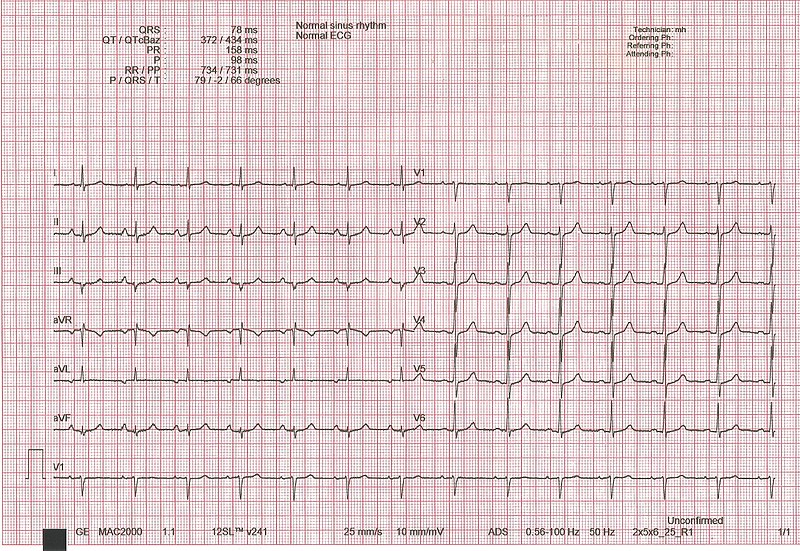Playlist
Show Playlist
Hide Playlist
Mean Electrical Axis and Determining Axis on ECG – Electrocardiogram
-
Slides CV Physiology-Electrocardiogram.pdf
-
Download Lecture Overview
00:01 Okay. 00:02 Let's combine our augmented leads – aVR, aVL, aVF – with our standard limb leads, 1, 2, and 3. 00:11 So, now, we have six different pictures of the heart around one single plane. 00:18 So, this is along the frontal plane here. 00:22 And each of the arrow tips represent where the positive pole is. 00:28 So, the negative pole is on the opposite side of the arrow. 00:33 A depolarization traveling towards a positive pole is going to give you a positive deflection. 00:40 And again, the maximal positive deflection will be closest to that mean vector. 00:48 And then, you need to look at what is the wave perpendicular, meaning that it would be a 90° angle from the line that you drew from that particular axis that had the highest deflection point. 01:02 Okay, we’ll come back to this and revisit it a couple of times, but just have that in your mind as we move forward. 01:11 One plane, this plane right here; six different views, you have them. 01:17 And we can all put them around one circle. 01:20 And algebraically, one circle is 360°. 01:24 So, we're going to give certain leads a degree. 01:30 And this is going to be a helpful way for us to assess if someone's heart is normal or not based upon what degree their mean electrical axis might be. 01:41 Okay. 01:42 We need to build on some of that process and that is we need to talk about what really is a mean electrical axis. 01:49 A mean electrical axis should be somewhere in between about negative 30 to 100. 01:56 That's the normal range for mean electrical axis. 02:00 Some people will say that normal is in between 0 and 90, and that's okay too. 02:06 I'm just giving you a little bit wider range. 02:08 Not everybody always agrees in medicine what is normal and what's abnormal. 02:14 So, it's either 0 to 90 or negative 30 to 100. 02:18 Two good ways to think about it. 02:21 Your mean electrical axis should lie somewhere in between that range. 02:29 Two pathologies will affect this. 02:32 If you have hypertrophy, the mean electrical axis will move towards a hypertrophy. 02:40 If you have a myocardial infarction – that is a heart attack – the mean electrical axis will move away from the heart attack. 02:48 So, you move towards hypertrophy or away from heart attack. 02:54 So, knowing that information, let’s go calculate a couple. 03:01 So, let’s take this example here and where we are looking first for which particular wave is the most biphasic. 03:10 What do we mean by biphasic? Can't we just use simple words? I know it's frustrating, but let's work through it. 03:18 Biphasic means that your positive deflection equals your negative deflection. 03:25 So, whichever electrode lead shows an equal positive deflection versus a negative deflection, okay? So, it has to have a blip up and a blip down and those two amplitudes need to be very similar. 03:42 You're looking for that lead. 03:44 Then, you want to look for the lead that’s 90° from it. 03:50 And you want to see which one is 90° from it, closest to 90° from it, has a positive electrode deflection. 04:01 Okay. 04:01 Let's go through two examples. 04:03 Everybody needs examples. 04:05 When you first learn this, it’s very hard. 04:07 So, you just need an example. 04:08 You need to walk through a couple. 04:09 So, let’s take one. 04:12 If standard limb lead 1 is biphasic and aVF is the most positive, the mean electrical axis is 90. 04:23 So, if you traced this out, you could see standard limb lead 1. 04:28 That’s that arrow that's going towards zero here, right there. 04:33 That's going towards zero. 04:36 That would be your most biphasic. 04:41 aVF is located perpendicular to standard limb lead one, and that is a direct downward movement. 04:52 If that is a positive deflection, that gives you your mean electrical axis a positive 90. 05:00 If we take a second example, let's say aVL, so here we have aVL. 05:06 If that is the most biphasic, you'd want to take what is 90° from that, and so that would be standard limb lead 2. 05:14 That’s standard limb lead 2, therefore, you would have the most positive deflection that would give you a mean electrical axis of 60. 05:26 Those two examples are normal mean electrical axes. 05:30 Why? Because mean electrical axes should be somewhere between negative 30 and 100. 05:36 Both 90 and 60 fall within those means, and therefore, that is a normal ECG. 05:44 Remember our two pathologies. 05:46 If you have hypertrophy, it will cause a shift towards the hypertrophy. 05:50 If you have an infarction, it will shift it away from the infarction.
About the Lecture
The lecture Mean Electrical Axis and Determining Axis on ECG – Electrocardiogram by Thad Wilson, PhD is from the course Cardiac Physiology.
Included Quiz Questions
What would the mean electrical axis be if aVR is the most biphasic, and standard limb lead III is the most positive?
- +120°
- -150°
- -30°
- +60°
- 0°
What is the normal range for the mean electrical axis?
- -30° to +100°
- -50° to +90°
- -10° to +50°
- -90° to +100°
- -20° to +110°
What is the mean electrical axis if standard limb lead I is biphasic, and aVF is the most positive?
- +90°
- +70°
- -120°
- +120°
- +30°
Which frontal plane lead would have the greatest (tallest) r-wave if the mean electrical axis is 60°?
- Lead II
- Lead I
- aVR
- aVL
- Lead III
Customer reviews
3,7 of 5 stars
| 5 Stars |
|
1 |
| 4 Stars |
|
0 |
| 3 Stars |
|
2 |
| 2 Stars |
|
0 |
| 1 Star |
|
0 |
complicated, i studied it much easier in different location than here
Helps to understand the basics of ECG. More videos on abnormal ECG would be of great use.
As general principles this can be ok.It is missing examples of ECG tracing on real ECG papers to recognize the normal mean axis in practical way.Would you please do a lecture showing the normal axis and axis deviation in hypertrophy and ischemia






